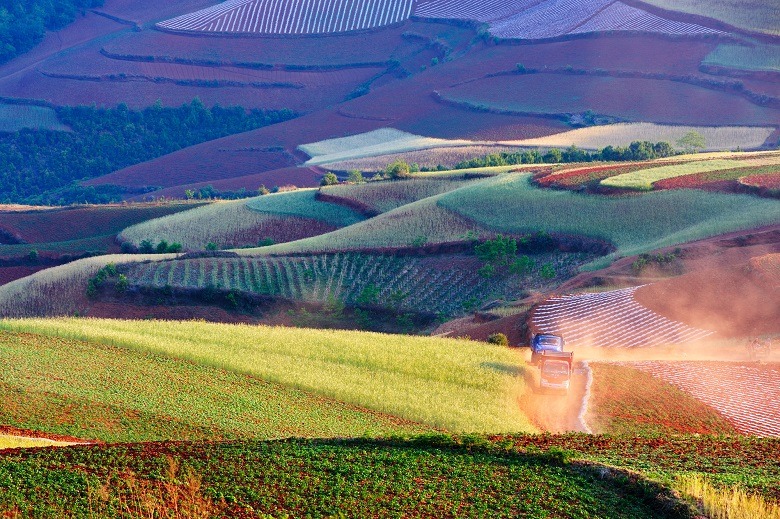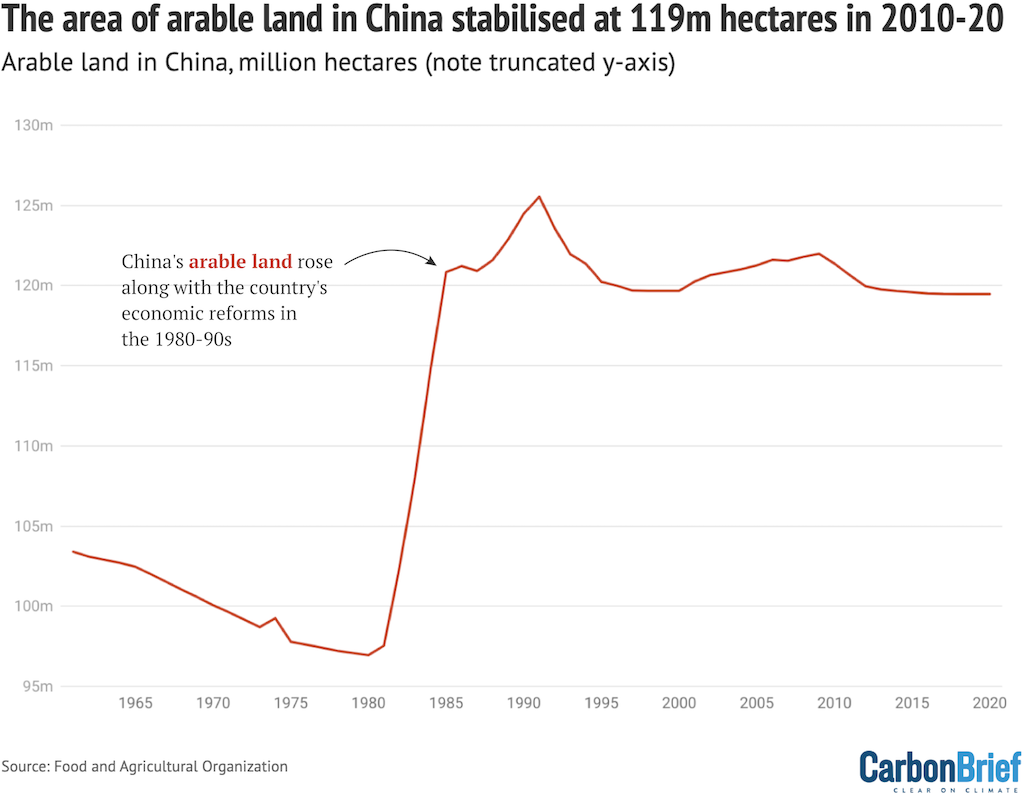
| China experienced both extreme heat and “devastating” floods this summer, which had an impact” on food supplies and rice crops. This Carbon Brief article on how climate change is affecting China’s cropland, looks at arable land policies and potential impacts of climate on food security. |
Official Chinese data shows that at least 1.9m hectares (19,000km2) or 8% of wheat land in China have been affected by a sustained spate of rains – with “agricultural challenges” set to continue throughout the rest of the year.
The UN’s Intergovernmental Panel on Climate Change (IPCC) and World Bank both stress that further loss and damage is expected across China’s farming sector as global temperatures continue to rise.
But what, specifically, is happening to China’s arable land? And how does China plan to minimise the negative impacts of climate change on its wider food system?
In this Q&A, Carbon Brief looks at China’s cropland policies.
- What challenges does Chinese farming face under climate change?
- What impact will climate change have on China’s food security?
- How much arable land does China have?
- How will China balance food security with forestry and renewable energy?
What challenges does Chinese farming face under climate change?
In 2022, China suffered from its worst heatwave and drought in six decades. The ministry of agriculture and rural affairs stated at a press conference last August that the agricultural sector was facing “growing risks” as a result of extreme weather and shifting planting conditions brought about by climate change.
This summer, severe drought continued to affect China in June and July, while a torrent of floods brought on by typhoons followed in August. The heavy rains have destroyed corn and rice crops in north China, while in central China’s Henan province more than 20m tonnes of wheat were lost in June alone.
Although the agriculture ministry insists the country has experienced a “summer harvest”, the summer’s grain output decreased 2.55bn jin (1.53m tonnes) from last year’s total of 147m tonnes.
However, the US department of agriculture predicts that 2023 may not end up being a poor harvest year for China. Only sunflower seeds, barley and cotton are likely to see a reduction in production. The output of main crops, including corn, rice and wheat, would surpass the average output of the past five years.
Corey Lesk, research associate from the geography department at Dartmouth College in the US, tells Carbon Brief that “in some sense, China’s crops are not that vulnerable to climate warming”.
Broadly, China’s main food crops are wheat in the north and rice in the south. “The south is already warm and sub-tropical,” says Lesk, “[and rice] is well-understood to be more resilient to extreme heat”.
In the north, Lesk says warming will lengthen the growing season and increase yield potential for wheat as well as enable farmers to “plant multiple crops” in a single year at a higher latitude. “Combining these effects, in the north, crop models show only small yield losses under plausible warming scenarios,” he adds.
Haishun Yang, an associate professor from the department of agronomy and horticulture at the University of Nebraska – Lincoln, shares a similar view:
“Globally speaking, crop yield per ground area as well as the total crop production have been increasing constantly along with the climate change. China is the same as most parts of the world.”
However, Lesk warns that “there are caveats”. He says: “Those crop models are known to not realistically simulate the impact of heat extremes, in particular, so likely underestimate true impacts [of climate change].”
The most recent IPCC report has “high confidence” that, globally, “climate-related extremes have affected the productivity of all agricultural and fishery sectors, with negative consequences for food security and livelihoods”. China is no exception.
Dr Zhang Hongzhou, research fellow from Nanyang Technological University, Singapore, tells Carbon Brief:
“More occurrences of extreme climate events, such as flood, drought and typhoon, will certainly present major risks to the country’s [China] food security both in the short term and long term.”
“While certain regions or crops might benefit from a warm climate, based on existing studies, the overall impact seems to be negative. In short, climate change is a major threat to the country’s [China’s] food security.”
What impact will climate change have on China’s food security?
A study published earlier this year in Nature found that extreme rainfall has suppressed Chinese rice yields by around 8% over the past two decades. A review of hundreds of studies, published in the journal International Journal of Environmental Research and Public Health, concluded that rice yields in China were likely to decline by 5-25% after the 2060s.
China’s third national assessment report written by the ministry of ecology and environment in 2018 already acknowledged the negative consequences. It said:
“Climate change has significantly impacted cropping systems in China, as well as the occurrence, development and damage caused by disease and pests, and the growth, development and yield of crops.”
The report also said that climate change would bring less reliable rains, the spread of dangerous pests and shorter growing seasons for many crops.
Meanwhile, Lesk tells Carbon Brief that climate change directly threatens the farming of pork – China’s most consumed meat by volume.
China consumes about 45% of the world’s pork at more than double the world’s average per capita consumption. (See more on Carbon Brief’s analysis on China’s food system).
Lesk says pork in China is “very dependent” on soya beans, which accounts for up to 90% of a pig’s feed. Soya beans, although mostly imported from the Americas, are “quite vulnerable to future extremes”.
Lesk thinks that “while the climate risk to China’s own crops is perhaps somewhat lower than other countries, its exposure to distant risks is quite high in this respect”.
Tang Renjian, China’s minister of agriculture and rural affairs, has stated that the Chinese population needs 700,000 tonnes of grain, 98,000 tonnes of edible oil, 1.92m tonnes of vegetables and 230,000 tonnes of meat on a daily basis.
This means the nation’s “cultivated land must be kept at 1.8bn mu (about 120m hectares), which is the bottom line and cannot be lowered” to meet such demand, he said.
So, does China have enough cultivated land?
How much arable land does China have?
The Chinese government claims that China had 127.6m hectares of arable land at the end of 2022, which is about 9% of the world’s total.
The most recent data from the Food and Agriculture Organisation shows that China’s arable land remained at around 119m hectares (12% of its land area) between 2012 to 2020, which is smaller than the Chinese official data, which shows 128m hectares, as of 31 December 2019.
As the chart below shows, the area of cultivated land has slowly decreased over the past 10 years, after seeing a rapid increase in the 1980s in line with China’s economic reform in the rural areas. The Chinese ministry of agriculture and rural affairs announced a loss of 113m mu (7.5m hectares) in the summer of 2021.

Change of arable land in China in hectares from 1961–2020. Source: FAO.
The official explanation for the loss is “mainly due to agricultural structural adjustment and afforestation” – 7.4m hectares became forest land and 4.2m hectares were turned into gardens from 2011 to 2021, says the government.
Data from the FAO also shows that forest cover in China grew 17.4m hectares from 2011-20.
However, the Guide to Chinese Climate Policy 2022, published by the Oxford Institute of Energy Studies, raised doubt about the accuracy of the official statistics. It says that China’s “forest” cover is larger than the area of “forest” defined internationally due to the “systemic over-reporting of tree cover”. Global Forest Watch, an NGO, also says that, from 2013 to 2021, China lost 3.7m hectares of natural forest – a 2.7% decrease.
Yang tells Carbon Brief that “the balance between food security and forestry is tricky”. He adds:
“Food security is a tangible and rigid attribute, whereas forestry is a soft and elastic one…After satisfying all basic land uses (residential, transportation, etc), forestry should be promoted as a way to improve ecosystem quality and sustainability.”
The government remains typically upbeat. In 2009, the Chinese government announced it had “solved the problem of food”. Chinese president Xi Jinping said in 2023 that China’s new mission is to build “a beautiful China”, which “features harmony between humans and nature”.
So how does China plan to maintain – or even increase – forests while feeding its 1.4 billion people?
How will China balance food security with forestry and renewable energy?
China has made the “Sannong” policy (meaning agriculture, rural areas and farmers) the core of its agriculture policy. Since 2004, China’s annual “No. 1 central document” – the first and, arguably, the most important policy statement – has been related to food security. The government drew a protective “red line” around 1.8b mu (about 120m hectares) of arable land in 2006 to ensure food security.
In 2023, the No.1 document says the country needs to “ensure the national grain output remains above 1.3tn jin (780m tonnes)”. Also in 2023, the ministry of natural resources reiterated that “China will strictly stick to a ‘red line’ on the size of arable land the country owns”.
Yang argues that “enough food” is a “hard goal”. He adds: “If China simply needs more food and can’t acquire the deficit from outside, it has to use all the resources to make it.”
China recently revised the land management law and issued a notice strictly controlling farmland use, as well as requiring that “permanent basic farmland” not be converted to other land, such as forest land.
If farmland were to be transferred, it needs to follow two principles: “jin chu ping heng” (striking a balance between land “outflow” and “inflow”); and “zhan bu ping heng” (striking a balance between land occupation and compensation). The two principles aim to keep the overall amount of arable land and forest land unchanged.
Yang tells Carbon Brief:
“For the balance between land occupation and compensation, we would fool ourselves if we compensate for the area of occupied land. What we need to compensate [for] is the lost crop output capacity.
If we have to maintain the crop output capacity, we need to convert other lands (e.g. forest or grassland) into crop production. Usually, especially in China, the crop’s natural yield (i.e. without resource and technology investments) of other lands is lower than current crop lands. The same area of newly converted lands will have lower crop output capacity than the occupied lands. We must either convert more other lands, or invest accordingly, e.g. in irrigation, land levelling and soil fertility to fully compensate [for] the lost crop output capacity.”
Zhang also points out the need for investment in other related fields:
“In order to strike a balance between food security and sustainability, China needs to better utilise international trade, more investments [in] agricultural tech, and in foreign agricultural diversified trade, better global food governance.”
Additionally, China’s current policy encourages construction, including solar farms, to be built on unused land, such as the deserts in the far west.
New construction and expansion of the solar projects “shall not occupy permanent basic farmland, basic grassland, ‘class I’ protected forest land, and key state-owned forest areas”, stresses the document.
Source: Carbon Brief, 24 Aug 2023.
https://www.carbonbrief.org/qa-how-is-climate-change-affecting-chinas-cropland/